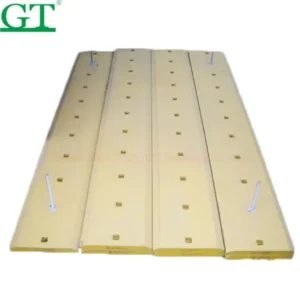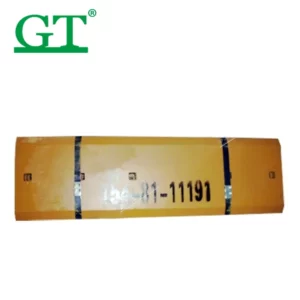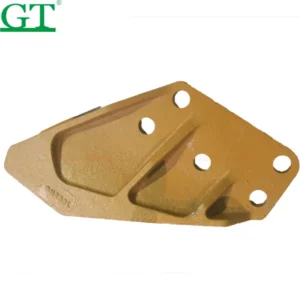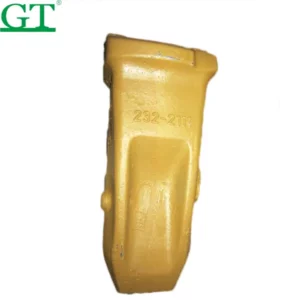Product Categories
Related products
Forged Bucket Teeth Wtih PC200RC PC300RC PC300TL PC400RC Heavy Duty For Komatsu Excavator
Forging is a process that using forging machine to maket the metal blank produce plastic deformation, in order to obtain a certain mechanical properties, shape and size. Through forging can eliminate the metal ascast loose defects in the smelting process, optimize the microstructure, keep the complete metal flow, so the mechanical propertites of forging is generally better than casting of the same materail. Most of the machine important parts whcih require high load and serious working condition apply forging parts.
Categories: Bucket Tooth & Adapter, Ground Engaging Tools
Forging Advantage
| Item | Forging | Casting | |
|---|---|---|---|
| Process | Forging is a process that using forging machine to maket the metal blank produce plastic deformation, in order to obtain a certain mechanical properties, shape and size. Through forging can eliminate the metal ascast loose defects in the smelting process, optimize the microstructure, keep the complete metal flow, so the mechanical propertites of forging is generally better than casting of the same materail. Most of the machine important parts whcih require high load and serious working condition apply forging parts. | Casting is a process that putting the liquid metal into the casting cavity, after cooling and solidification to get the required parts. | |
| Material | Forging material widely use round steel, square steel. there are carbon steel, alloy steel, stainless steel as well as some non-ferrous metal whichr mainly applied in areospace and precision industry. | Casting usually adopt gray cast iron, dectile cast iron, malleable cast iron, and “cast steel. Common casting non-ferrous metal: brass, tin bronze, wuxi bronze, aluminum alloy etc. | Under the equivalent condition, forgingmetal has better performance in mechanical properties, while casting is superior in molding. |
| Apperance | Oxidation reaction of forging steel during the high temperature process will cause slight kylin grain in the surface of the forged bucket teeth. Also as forging is made by molding, after removing the allowance slot in the mould, there would be a parting line in the forged bucket teeth. | There are sand trace and casting kiting in the surface of casting bucket teeth. | |
| Mechanical Property | Forging process can gurantee the continuity of metal fibre, and keep complete metal flow, gurantee good mechanical properties and long service life of the bucket teeth, which casting process is incomparable. | Compared to casting parts, metal’ s structure and mechanical properties can be improved after forging. The casting organization after forging thermal deformation, the original bulky crystal and columnar grain change into fine grains, and uniform isometric recystallization organization, let the structure of original segregation inside ingot, osteoporosis, porosity slag inclusion and other compact to be more closely, thus improve the metal plasticity and mechanical properties. Forging is to get the required shape by pressing the metal through plastic deformation, usually by a hammer or pressure. Forging process offers fine granular structure, and improves the metal physical properties, in practical use, a proper design can guarantee the grain flow in the direction of main stress. While casting is to acquire metal forming objects through all kinds of casting methods, that is to put the liquid metal into the prepared mold to get a certain shape, size and properties, by smelting, casting, injection or other casting method, and shakeout after cooling, cleaning and final-treatment. |
|
Forging Teeth Show

Forging Teeth List
| Forging Bucket Tooth | ||||
|---|---|---|---|---|
| PART NUMBER | MODEL | U′WT(KG) | TOTAL LENGTH | DIAMETER |
| 205-70-19570 | PC200RC | 5.8 | 265 | ∅29 |
| 205-70-19570 | PC200RCQ | 4.7 | ∅29 | |
| 207-70-14151 | PC300RC | 10 | 310 | ∅30 |
| 207-70-14151 | PC300RC(Q) | 8.5 | 305 | ∅30 |
| 208-70-14152 | PC400RC | 14.2 | 345 | ∅35 |
| 2713-1217 | DH220RC | 5.7 | 257 | ∅23 |
| 2713-1219 | DH300RC | 7.8 | 288 | ∅25 |
| 2713-0032 | DH360RC | 11 | 314 | ∅27 |
| 2713-1236 | DH420RC/DH500 | 16.3 | 350 | ∅29.5 |
| 1U3352 | E320RC | 7.3 | 275 | ∅26 |
| 1U3352 | E320RC | 8.5 | 285 | ∅26 |
| 7T3402RC | E325RC/SK330 | 10.6 | 310 | ∅27 |
| 9W8452 | E330RC | 13.7 | 336 | ∅30.4 |
| 9W8552RC | E345RC | 24.2 | 390 | ∅35 |
| 14530544RC | EC210RC | 7.7 | 288 | ∅28 |
| 14536800RC | VOL360RC/EC460 | 15.5 | 341 | ∅34.5 |
| EC480RC | 20.3 | 372 | ∅38 | |
| 205-70-19570TL | PC200TL | 5.5 | ∅29 | |
| 14536800TL | VOL360TL | 12 | 430 | ∅34.5 |
| 208-70-14152TL | PC400TL | 12.5 | 410 | ∅35 |
Forging Teeth Packing

← HITACHI OEM Sprocket EX200 Excacator Spare Parts EX100 EX300
Alloy Steel Material PC400 Excavator Bucket Teeth Good Price with High Quality 2057019570 →
Product Categories
Leave Your Message
Related products
-

China manufacture Curved Grader Blades Cutting Edge with 5D9553 222-80-05003 040100050
-

Bulldozer Dozer Grader Blade End Bits Cutting Edge for 220-9097 and Equipment Used Carbon Boron Steel 220-9099 220-9094 220-9112
-

Komatsu Dozer Blade Cutting Edge 4T6381
-

Sell OEM Boron Steel 8E5531 Grader End Bit Dozer Cutting Edge









